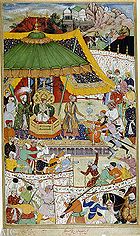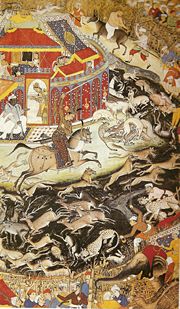
Akbarnama
Encyclopedia

Persian language
Persian is an Iranian language within the Indo-Iranian branch of the Indo-European languages. It is primarily spoken in Iran, Afghanistan, Tajikistan and countries which historically came under Persian influence...
by his court historian and biographer, Abul Fazl
Abu'l-Fazl ibn Mubarak
Shaikh Abu al-Fazl ibn Mubarak also known as Abu'l-Fazl, Abu'l Fadl and Abu'l-Fadl 'Allami was the vizier of the great Mughal emperor Akbar, and author of the Akbarnama, the official history of Akbar's reign in three volumes, and a Persian translation of the Bible...
who was one of the nine jewels in Akbar's court. It includes vivid and detailed descriptions of his life and times.
History
Abul FazlAbu'l-Fazl ibn Mubarak
Shaikh Abu al-Fazl ibn Mubarak also known as Abu'l-Fazl, Abu'l Fadl and Abu'l-Fadl 'Allami was the vizier of the great Mughal emperor Akbar, and author of the Akbarnama, the official history of Akbar's reign in three volumes, and a Persian translation of the Bible...
wrote the work between 1590 and 1596 and is thought to have been illustrated between c. 1592 and 1594 by at least forty-nine different artists from Akbar's studio.
The work was commissioned by Akbar, and written by Abul Fazl
Abu'l-Fazl ibn Mubarak
Shaikh Abu al-Fazl ibn Mubarak also known as Abu'l-Fazl, Abu'l Fadl and Abu'l-Fadl 'Allami was the vizier of the great Mughal emperor Akbar, and author of the Akbarnama, the official history of Akbar's reign in three volumes, and a Persian translation of the Bible...
, one of the Nine Jewels (Hindi
Hindi
Standard Hindi, or more precisely Modern Standard Hindi, also known as Manak Hindi , High Hindi, Nagari Hindi, and Literary Hindi, is a standardized and sanskritized register of the Hindustani language derived from the Khariboli dialect of Delhi...
: Navaratnas
Navaratnas
Navaratnas Nauratan was a term applied to a group of nine extraordinary people in a emperor's court in India...
) of Akbar’s royal court. It is stated that the book took seven years to be completed and the original manuscripts contained a number of paintings supporting the texts, and all the paintings represented the Mughal school of painting
Mughal painting
Mughal painting is a particular style of South Asian painting, generally confined to miniatures either as book illustrations or as single works to be kept in albums, which emerged from Persian miniature painting, with Indian Hindu, Jain, and Buddhist influences, and developed largely in the court...
, and work of masters of the imperial workshop, including Basawan
Basawan
Basawan, or Basavan , was an Indian miniature painter in the Mughal style. He was known by his contemporaries as a skilled colorist and keen observer of human nature, and for his use of portraiture in the illustrations of Akbarnama, Mughal Emperor, Akbar's official Biography, which is seen as an...
, whose use of portraiture in its illustrations was an innovation in Indian art
Indian art
Indian Art is the visual art produced on the Indian subcontinent from about the 3rd millennium BC to modern times. To viewers schooled in the Western tradition, Indian art may seem overly ornate and sensuous; appreciation of its refinement comes only gradually, as a rule. Voluptuous feeling is...
.
After Akbar's death in 1605, the manuscript remained in the library of his son, Jahangir (r. 1605-1627) and later Shah Jahan (r. 1628-1658). Today, the illustrated manuscript of Akbarnma, with 116 miniature paintings, is at the Victoria & Albert Museum. It was bought by the South Kensington Museum (now the V&A) in 1896 from Mrs Frances Clarke, acquired by her husband upon his retirement from serving as Commissioner of Oudh (1858-1862). Soon, after the paintings and illuminated frontispiece were removed from the volume to be mounted and framed for display.
Volumes I and II
The first volume of Akbarnama deals with the birth of Akbar, the history of Timur's family and the reigns of Babur and HumayunHumayun
Nasir ud-din Muhammad Humayun was the second Mughal Emperor who ruled present day Afghanistan, Pakistan, and parts of northern India from 1530–1540 and again from 1555–1556. Like his father, Babur, he lost his kingdom early, but with Persian aid, he eventually regained an even larger one...
and the Suri sultans of Delhi
Delhi
Delhi , officially National Capital Territory of Delhi , is the largest metropolis by area and the second-largest by population in India, next to Mumbai. It is the eighth largest metropolis in the world by population with 16,753,265 inhabitants in the Territory at the 2011 Census...
. The second volume describes the detailed history of the reign of Akbar till 1602 and records the events during Akbar's reign.
Volume III: The Ain-i-Akbari

Mughal Empire
The Mughal Empire , or Mogul Empire in traditional English usage, was an imperial power from the Indian Subcontinent. The Mughal emperors were descendants of the Timurids...
as well as containing the famous "Account of the Hindu Sciences". It also deals with Akbar's household, army, the revenues and the geography of the empire. It also produces rich details about the traditions and culture of the people living in India. It is famous for its rich statistical details about things as diverse as crop yields,prices,wages and revenues. Here Abu'l Fazl's ambition, in hithe learned among the Hindus. I know not whether the love of my native land has been the attracting influence or exactness of historical research and genuine truthfulness of narrative..." (Ā’in-i-Akbarī, translated by Helen Blochmann, Volume III, pp 7). In this section, he expounds the major beliefs of not the six major Hindu philosophical schools of thought, and those of the Jains, Buddhists, and Nāstikas. He also gives several Indian accounts of geography, cosmography, and some tidbits on Indian aesthetic thought. Most of this information is derived from Sanskrit texts and knowledge systems. Abu'l Fazl admits that he did not know Sanskrit and it is thought that he accessed this information through intermediaries, likely Jains who were favoured at Akbar's court.
In his description of Hinduism, Abu’l Fazl tries to relate everything back to something that the Muslims could understand. Many of the orthodox Muslims thought that the Hindus were guilty of two of the greatest sins, polytheism and idolatry.
On the topic of idolatry, Abu’l Fazl says that the symbols and images that the Hindus carry are not idols, but merely are there to keep their minds from wandering. He writes that only serving and worshipping God is required.
Abul Fazl also describes the Caste system to his readers. He writes the name, rank, and duties of each caste. He then goes on to describe the sixteen subclasses which come from intermarriage among the main four.
Abu’l Fazl next writes about Karma about which he writes, “This is a system of knowledge of an amazing and extraordinary character, in which the learned of Hindustan concur without dissenting opinion.” He places the actions and what event they bring about in the next life into four different kinds. First, he writes many of the different ways in which a person from one class can be born into a different class in the next life and some of the ways in which a change in gender can be brought about. He classifies the second kind as the different diseases and sicknesses one suffers from. The third kind is actions which cause a woman to be barren, or the death of a child. And the fourth kind deals with money and generosity, or lack thereof.
The Akbarnama of Faizi Sirhindi
The Akbarnama of Shaikh Illahdad Faiz Sirhindi is another contemporary biography of the Mughal emperor Akbar. This work is mostly not original and basically a compilation from the Tabaqat-i-Akbari of Khwaja Nizam-ud-Din AhmadNizamuddin Ahmad
Khwaja Nizam-ud-Din Ahmad was a Muslim historian of late medieval India. He was son of Muhammad Muqim-i-Harawi. He was Akbar's Mir Bakhshi...
and the more famous Akbarnama of Abu´l Fazl. The only original elements in this work are a few verses and some interesting stories. Very little is known about the writer of this Akbarnama. His father Mulla Ali Sher Sirhindi was a scholar and Khwaja Nizam-ud-Din Ahmad
Nizamuddin Ahmad
Khwaja Nizam-ud-Din Ahmad was a Muslim historian of late medieval India. He was son of Muhammad Muqim-i-Harawi. He was Akbar's Mir Bakhshi...
, the writer of the Tabaqat-i-Akbari was his student. He lived in Sirhind sarkar of Delhi
Delhi
Delhi , officially National Capital Territory of Delhi , is the largest metropolis by area and the second-largest by population in India, next to Mumbai. It is the eighth largest metropolis in the world by population with 16,753,265 inhabitants in the Territory at the 2011 Census...
Subah
Subah
A Subah was a province of the Mughal Empire in South Asia. The governor of a subah was known as a subahdar, which later became subedar to refer to an officer in the Indian Army...
and held a madad-i-ma´ash (a land granted by the state for maintenance) village there. He accompanied his employer and patron Shaikh Farid Bokhari (who held the post of the Bakhshi-ul-Mulk) on his various services. His most important work is a dictionary, the Madar-ul-Afazil, completed in 1592. He started writing this Akbarnama at the age of 36 years. His work also ends in 1602 like the one of Abu´l Fazl. This work provides us some additional information regarding the services rendered by Shaikh Farid Bokhari. It also provides valuable information regarding the siege and capture of Asirgarh.
Translations
- Beveridge HenryHenry BeveridgeHenry Beveridge was an Indian Civil Service officer and Orientalist in British India. He is one the few administrator-historians who studied Indian affairs with a radical outlook....
. (tr.) (1902-39, Reprint 2010). The Akbarnama of Abu-L-Fazl, Vol. I & II, Delhi: Low Price Publications, ISBN 81-7536-482-3. - Beveridge HenryHenry BeveridgeHenry Beveridge was an Indian Civil Service officer and Orientalist in British India. He is one the few administrator-historians who studied Indian affairs with a radical outlook....
. (tr.) (1902-39, Reprint 2010). The Akbarnama of Abu-L-Fazl, Vol. III, Delhi: Low Price Publications, ISBN 81-7536-483-1. - Beveridge HenryHenry BeveridgeHenry Beveridge was an Indian Civil Service officer and Orientalist in British India. He is one the few administrator-historians who studied Indian affairs with a radical outlook....
. (tr.) (1902-39, Reprint 2010). The Akbarnama of Abu-L-Fazl, Set of 3 Volumes, Bound in 2, Delhi: Low Price Publications, ISBN 81-7536-481-5.
Work online
(Online book)External links
- A resource site on Akbarnama, by Columbia University
- Akabrnama Online search through collection at Victoria and Albert MuseumVictoria and Albert MuseumThe Victoria and Albert Museum , set in the Brompton district of The Royal Borough of Kensington and Chelsea, London, England, is the world's largest museum of decorative arts and design, housing a permanent collection of over 4.5 million objects...

